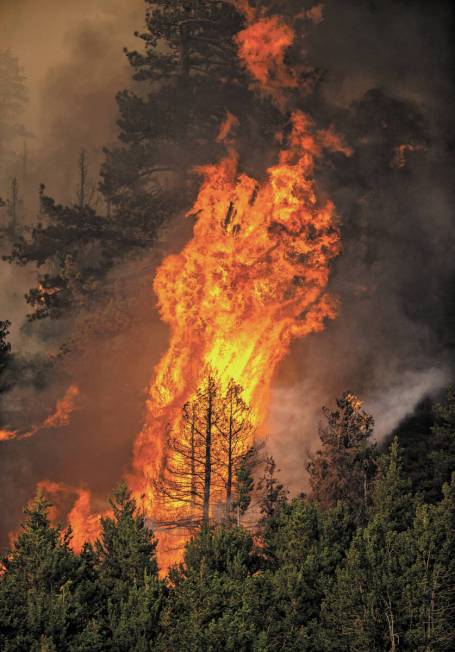Crews make gains as Caldor Fire slows near Lake Tahoe

CARSON CITY — The Caldor Fire south of Lake Tahoe saw its slowest growth in days Thursday as winds that receded overnight stayed down all day.
The reduced winds helped fire crews make gains toward containing the fire, keeping it from advancing on populated areas or the lake, authorities reported Thursday night.
The 7 p.m. update from the joint fire incident team put the size of the blaze at 210,893 acres, an increase of 633 acres since the 7 a.m. report. It was a sharp change from the galloping advances that have burned through roughly 329 square miles. Containment was at 27 percent, up 2 percentage points on the day. More than 4,400 firefighters and other personnel are assigned to fire operations.
The fire has destroyed 650 homes and nearly 200 other structures and still threatens nearly 32,000 more. Reported injuries remain at five, three involving firefighters and two to civilians.
The fire command response is divided into east and west zones, with the eastern section covering an area that includes South Lake Tahoe. Progress in the western zone Thursday allowed officials to roll back evacuation orders and warnings, allowing residents to return.
Evacuation orders and warnings remain in effect for sections of Douglas County on the Nevada side of the fire.
“Nothing has changed in Douglas County as far as evacuations,” Sheriff Daniel Coverley said in a 5 p.m. community briefing Thursday. “And as always, you don’t have to wait for me to order you to leave. If you feel uncomfortable and want to get organized and get out, you can do that, and we encourage you to do that. Stay patient. These guys are doing a great job, and I think we’re in a good spot. So as soon as I can get you back into your homes, I will.”
The fire began Aug. 14 just south of the California community of Grizzly Flats in El Dorado County, about 35 miles southwest of South Lake Tahoe and 55 miles southwest of Carson City. Driven by prevailing winds, it sprinted to the northeast and came within 3 miles of South Lake Tahoe, forcing evacuations there and in several Nevada border communities.
Crossed the crest
Those winds made the Caldor blaze only the second wildfire in California history to run completely across the ridge of the Sierra Nevada range from west to east. The first, also this summer, was the Dixie Fire, which is still burning to the north in the Lassen National Forest, southwest of Susanville. That fire has consumed more than 859,000 acres and is 55 percent contained.
Thursday was forecast to be “a good day to not have gusty winds up on the ridges,” incident meteorologist Jim Dudley said at the 7 a.m. operational briefing. “The flow is much, much lighter, out of the south-southeast so you’re not going to get the atmosphere trying to increase your terrain winds today.”
Humidity levels also were better, but conditions remained dry, Dudley added. In the 5 p.m. briefing, Dudley said low-wind conditions would prevail again on Friday and into the weekend.
Stephen Vollmer, a California fire behavior analyst, said the dry conditions would continue to cause spot fires to pop up outside the fire’s perimeter and in previously unburnt areas.
“The conditions are still dry, the temperatures are still warm,” Vollmer said. Isolated islands of green in the fire’s interior “have been cooking for the last three or four days, and now they’re all dried out. It’s only going to take one tree or one bush in there to get the whole island going.”
Southern Nevada crews
With upper-level winds diminishing, the fire is expected to follow prevailing ground-level winds that flow uphill during the day as the air warms and downhill at night as it cools, fire officials said. Clark County Fire Battalion Chief Kenny Holding, part of a Las Vegas-area contingent helping with area fire protection, said officials in a virtual briefing Thursday discussed the potential for the fire to follow those winds eastward and down the slopes toward Gardnerville and Minden in Douglas County.
Holden’s crew is backing up local fire crews from Gardnerville who are assigned to the Caldor fire. He said there is no imminent threat to the area, and no evacuations are being considered.
“It’s going to depend on the progress of the fire and the Department of Emergency Management would make the call when large-scale evacuations would happen for that community,” Holden said.
Contact Capital Bureau reporter Bill Dentzer at bdentzer@reviewjournal.com. Follow @DentzerNews on Twitter. Review-Journal staff writer Mick Akers contributed to this report.